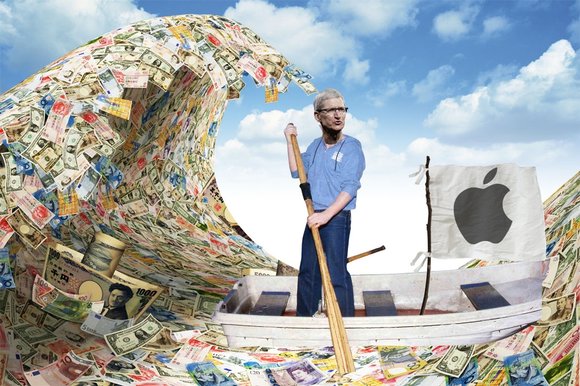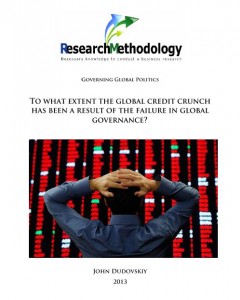Posts Tagged ‘crisis’

The twenty first century has been accepted as a century of information with the amount of information increasing with a geometrical progression, however this tendency is associated with a set of challenges that include protection of intellectual property which can be defined as any patterns of original creation that can be purchased or sold. Main forms of intellectual property protection are patenting, trademarks, trade secrets and copyright. Patenting is a popular way of protecting intellectual property, and patents are obtained for inventions that have potentials to generate revenues for inventor. Patents allow the patent holder to market the invention and patenting rights to the third party or license the invention when retaining intellectual property rights. Patents are considered to be intangible assets and many global businesses possess considerable amount of such type of asset. For example, gross carrying amount of patents of Ford Motor Company has exceeded USD 27 million by 2012 with the net carrying amount of USD 7 millions (Annual Report, 2012). Due to increasing numbers of innovations, and willingness of businesses to take advantage of these innovations there are many patent infringement lawsuits amongst many multinational corporations at any given time. For example, one of the most recent and noteworthy patent infringement disputes is the one between Finland-based global communications corporations – Nokia and HTC its Taiwan-based direct competitor. Patent infringement dispute initiated by Nokia for the use of Broadcom and Qualcom chip for HTC One model has attracted extensive media coverage due to its scale and significance and Nokia has emerged as a victor in the dispute with detrimental impacts on HTC in terms of damage to the brand image and future profits (Arthur, 2013). Moreover, there are instances where businesses decide to end their patent infringement disputes due to cost considerations of lawsuits, damage to…

Burke (2012) links the impacts of the global economic crisis of 2008-2010 with spending cuts on education system by the UK government. Chalabi and Arnett (2013), on the other hand, make an interesting observation related to the issue. Specifically, according to Chalabi and Arnett (2013), the levels of GDP in the UK decreased by 2 per cent between 2008 and 2010, whereas the levels of public expenditure on education have increased by 8 per cent during the same period. A large-scale survey conducted by Education Institution (2009) has attempted to assess impacts of the global economic crisis on education in 48 countries, including the UK. Infrastructure, human resources (HR), and other needs of the UK education system have been found as a result of the survey. Infrastructure needs of UK education system, according to Education Institution (2009) relates to necessity to rebuilt primary schools. Other needs are found to relate to funding for high quality continuing professional development of teachers and challenges associated with reforming curriculum and qualification system. However, it is important to note that Education Institution (2009) findings only relate to education in public sector, and the level of relevance of data to private sector educational institutions are yet to be established. Burke (2012) considers dramatic reduction of numbers of graduate employment schemes offered by multinational companies in 2009 as the direct impact of the global economic crisis. Although, this argument appears to be convincing, Burke (2012) fails to back-up the claim through referring to relevant statistical data. Vaitilingam (2010) points to the risk of lifetime earning loss for a generation of graduates that join full-time workforce during or immediate aftermath of recession. According to Vaitilingam (2010), this situation may occur due to rapid increase in the supply of graduates compared to jobs caused by cuts on graduate…

National economy of the UK entered the period of recession on the fourth quarter of 2008. Review of literature has found consensus amongst authors about significant negative impacts of the global economic crisis of 2008-2010 on UK economy. The lowest level of recession in UK occurred in June 2009, when the decline of economy has amounted to 5.5 per cent compared to its peak in Quarter 1, 2008 (Vaitilingam, 2010). According to Bell and Blanchflower (2011), the crisis has resulted in substantial cuts on government spending, reduction on the levels of household spending, and has contributed to the emergence of uncertain and volatile investment climate. Impacts of the crisis on jobs in the UK have been analysed by Vaitilingam (2010) in a detailed manner. To be more specific, Vaitilingam (2010) assesses job-related impacts of the global economic crisis of 2008-2010 to include increase on the levels of unemployment and regional disparities in Britain’s economic geography. Additionally, Vaitilingam (2010) specifies low-educated and low-skilled employees, as well as, older workers to be most disadvantaged in terms of being negatively impacted from the crisis. Sobel (2012) draws attention to personal and emotional implications of the crisis to daily lives of people in the UK and elsewhere. According to Sobel (2012) due attention is not paid to this specific aspect of the crisis and the authors stresses the necessity for additional researches in this area. References Bell, D.N. & Blanchflower, D.G. (2011) “The crisis, policy reactions and attitudes to globalisation and jobs” WTO Sobel, A.C. (2012) “Birth of Hegemony: Crisis, Financial Revolution, and Emerging Global Networks” University of Chicago Press Vaitilingam, R. (2010) “Recession Britain: Findings from economic and social research” Economic & Research Council

There is a large volume of published studies analysing major reasons of the global economic crisis of 2008-2010. Excessive risk taking by financial institutions in the US combined with inefficiencies with US housing regulations is shown as primary causes of global recession by Roberts (2009) and Heng (2010). Heng (2010) offers detailed account of the issue and effectively demonstrates that US-based financial institutions have encouraged individuals with no adequate credit history to own homes and rapid decline of house prices, phenomenon known as ‘housing bubble’ has given start to a severe global financial and economic crisis. A study conducted by Sobel (2012) confirms excessive risk taking and inefficiencies with housing regulations as reasons behind the economic crisis and also discussed additional factors not mentioned by many other authors. Specifically, according to Sobel (2012), inadequacies in formulating interest rate policies, as well as, policies to suppress inflation in the US have also played major role in creation of environment that led to the global economic crisis of 2008-2010. Globalisation is perceived by Tan (2010) as one of the major enabling factors of the global economic crisis of 2008-2010. The topic of globalisation is addressed by Samson and Daft (2012) in great details. Specifically, Samson and Daft (2012) divide globalisation into four stages and cultural sensitivity and managerial assumptions in each stage in the following manner: 1. Domestic 2. International 3. Multinational 4. Global Strategic orientation Domestically oriented Export-oriented, multi-domestic Multinational Global Stage of development Initial foreign involvement Competitive positioning Exposition of international operations Global Cultural sensitivity Of little importance Very important Somew hat important Critically important Manager assumptions ‘one best way’ ‘many good ways’ ‘the least-cost way’ ‘many good ways’ Four stages of globalisation Source: Samson and Daft (2012) However, while linking financial crisis and globalisation, Tan (2010) fails to…

Explanation of the outbreak of the Great Recession of 2007-8 in a chronological order is necessary in order to provide detailed information about the case study, and link discussions and analysis in following chapters to specific events within the chronology. Date Event 2007 AugustOctober December Funds freezed by the US Federal ReserveRecord high at Dow Jones Official start of the recession in the US 2008 MarchJuly September October November Collapse of Bear SternsGDP fall of 0.6% confirmed Denmark as the first European economy to face recession Record unemployment rate in the US during the last 5 years Takeover of Fannie Mae and Freddie Mac US President George Bush signs USD 700 billion bailout fund Singapore is the first Asian country to face recession with the economy shrinking 6.3% Hong Kong confirmed as the 2nd Asian country to face recession 2009 JanuaryFebruary June GDP fall of 1.5% in 4thquarter of 2008, confirms the beginning of recession in the UKObama stimulus package signed Issue of Greece’s budget deficit emerge 2010 JanuaryApril October UK economy comes out of recession with a GDP growth of 0.1%Creation of 162,000 job in the UK Greece and Ireland are bailed out in the EU as a result of adoption of austerity measures 2011 April May Portugal asking for the EU help in dealing with its financesPlanning of a permanent rescue fund in EU by leaders of its members The loss of US AAA credit rating Approval of EURO 78 billion bailout for Portugal by EU leaders Chronology of the Great Recession of 2007-8 Source: Roberts (2009), Heng (2010) and Hetzel (2012) References Heng, M.S. (2010) The Great Recession: History, Ideology, Hubris and Nemesis, World Scientific Hetzel, R.L. (2012) The Great Recession: Market Failure or Policy Failure, Cambridge University Press Roberts ,M. (2009) The…

Business turnaround can be defined as financial recovery of the company after the period of poor performance. The financial recovery can be achieved through implementing a specific set of strategies by the senior level management. The most popular turnaround strategies include the following: Re-building around a profitable core business Re-branding Changing organisational culture. New product development Cost reduction through human resources downsizing and other measures The choice of turnaround strategies listed above by a company depends on a wide range of factors such as situation in the marketplace, availability of resources, the present pattern of organisational culture and others. Apple’s primary turnaround strategy relates to rebuilding around a profitable core business. Manufacturing of IPhone and IPad have proved to be highly profitable core business for Apple and the management is further increasing its focus on these core businesses through the introduction of IPad Mini, development of lower cost Iphones for emerging markets such as India and China, and committing to investment for further developments of IOS platform. Changing organisational culture can be specified as another turnaround strategy currently in use by Apple CEO Tim Cook. Under former CEO Steve Jobs, Apple organisational culture was famous for being overly harsh, competitive and even exploitative of employees. However, having a reputation for being a ‘nice guy’, Tim Cook is believed to be leading a ‘quiet cultural revolution’ to foster more communication between various levels of management and to make Apple nicer workplace in general. Specifically, the micro-management practice of former CEO Steve Jobs has been abandoned and the level of involvement of employees in strategic decision making has been increased. Moreover, new product development has been employed by Apple CEO as additional turnaround strategy. Apple is believed to be developing watches and television that might have the same impact on respective products…

Failure of plans in tourism industry, like any other industry is not a rare occasions. Plans may go wrong as a result of the impact of external environment, as well as, mistakes and shortcomings taken place in planning process. Shortcomings during the planning process resulting the in the failure of plans may take place in the following manners: Mistakes may occur during the first stage of planning process, which is study recognition and preparation. For example, management may decide to conduct relevant study on regional levels, when the scope of the study necessitates data collection on the national level, thus compromising the quality of the plan from the outset of the planning process. Moreover, individuals responsible for tourism planning may fail to formulate SMART objectives. In this case, objectives may be too vague and lack deadlines, and it would be not possible to assess the level of achievement of these objectives in an appropriate manner. Shortcomings planning process can also take place during the stage of survey of existing data. Specifically, such shortcomings may involve collection of outdated data, collection of irrelevant data, collection of data from biased and unreliable sources etc. Arguably, implementation of new surveys can be specified as one of the major stages in tourism planning process that accommodates the most mistakes. Such mistakes may be caused due to the incompetence and the lack of previous experiences and they may involve selection of inappropriate data collection tools, sampling mistakes, and others. Analysis of secondary and primary data can be mentioned as another stage in the planning process in tourism where mistakes can happen possibly resulting in the failure of the plan. Mistakes in data analysis may involve failure to identify common patterns within the information provided by survey respondents, failure to achieve a required level of depth…

This paper critically analyses the extent at which a failure in global governance contributed to the recent global credit crunch. The paper starts with discussing the primary reasons of the credit crunch of 2007-2009, and its implications on the global economy. This is followed by analysis of the current state of global governance, and its impact on credit crunch. Moreover, the paper highlights potentials for avoiding credit crunch in the future through improving global governance practices. The global economic and financial crisis of 2007 – 2009 has shed a light in inefficiencies of the international financial system and the current pattern of the global governance. The current system of global financial governance has found to be mainly insufficient to predict and contains financial instability. The need for efficient global governance needs a shift to an improved balance between the two worlds of financial globalization i.e. private financial activity and public financial governance (Porter, 2009). The credit crunch reveals great challenges and threats to the developed economies as well as developing states. The global banking industry, which was by far the most profitable sector in 2006, is in much trouble and the risk that this poses to the real economy is thoughtful (Wade, 2008). The global financial crisis of 2007-triggered by the sub-prime mortgage crisis in the spring previously led to a significant decrease in production in autumn 2008, which has continued in 2009 and went on to produce the spring of 2009 to the present day effects, both social (rising unemployment decrease in disposable income, declining demand, social problems) and political (government changes, erosion of confidence citizens in the performance of governments and the political class), and thus increased the difficulties of public finances in developed countries causing in 2010 a series of crises (Nesvetailova, 2010). 1. Introduction 1 2.…

Presence of world’s leading retailers such as Tesco, Sainsbury’s and Marks & Spenser, fierce competition in pricing and in other terms and difficulties of market entry are the main characteristics of UK retail industry. Despite such complexities, some retailers could manage to do better during the recession achieving even higher revenues and profits. Although lack of financial resources and higher risk aversion by investors caused many difficulties for the retailers, some of the retailers introduced new strategies such as price cut downs and reinforcing their current positions rather than expanding, which helped them sustain the temporary difficulties and overcome the recession. Two types of factors, direct and indirect impacts of recent financial recession on consumer spending during and after crisis have been discussed in the report of Office for National Statistics. Direct impacts are said to be uncertainty of income and high rates of unemployment with scarcity of finance to support public spending by the governments. Indirect impacts on the other hand are credit crunch of financial organizations which makes them unable to process their businesses of providing loans the businesses. The research by Burt et al (2009) analyse and examine the impacts of financial crisis on the consumer buying behaviour in the UK and lists the following factors that had direct impact on the consumer spending: job uncertainty, declining savings, increased risk aversion and lower disposable income. Due to these factor consumers restrained themselves from excessive spending as they used to and focused mostly on important things. Respondents who participated in the study expressed their opinions saying that due to uncertainty in their future income or at least decline in the income they no longer can afford to spend excessively as previously. As it has been stated earlier, disposable income is considered to be one of the main effects…

It is important to mention the value and importance of the retail industry to the economy of the UK. According to Mintel Report (2009), retail industry of the UK is considered to be highly important and contributing factor to the UK economy as it generates 16% of UK Gross Domestic Product. In addition, every third pound is generated through retailers and almost 11% of the UK workforce is employed in this industry. UK has some retail companies that are internationally recognized and growing rapidly. For example, only Tesco has more than 1100 stores within the UK and overseas and planning to expand towards emerging markets such as Hong Kong and India. It is also worth stating that according to Mintel Report (2009) despite high importance and value, UK retailers are considered to be low employee payers although senior level managers are paid relatively well. The period of recent financial crisis in the UK was from the second quarter of 2008 to the third quarter of 2009. It started with 6.4% decline in Gross Domestic Product of UK in the beginning of the period and started increasing by 0.4% only at the end of the period. During the recession, UK economy deteriorated continuously leading to high rates of unemployment which is about 5% at the end of the period. This accounted to 800,000 people out of job (Gooberman, 2010). Another aspect of UK economy and its vulnerability to the financial recession has been discussed in the study conducted by LSE (2008). According to the research, UK economy is vulnerable to the financial crisis due to its reliance and specialization mostly on financial services and trading activities. Decline of the importance of the financial sectors had more negative effect on overall UK economy as a result of higher unemployment rate in the…
